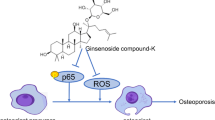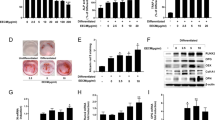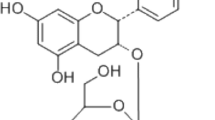Abstract
The interleukin-6 (IL-6) family of cytokines plays a key role in the pathogenesis of rheumatoid arthritis and osteoporosis through the regulation of bone formation and resorption. In this study, it was observed that ethanol extract of Salvia plebeia R.Br. (S.P-EE) inhibited IL-6-induced signaling cascade including phosphorylation of JAK2/STAT3 and ERK. Subsequently, it was examined whether S.P-EE treatment could recover bone loss in ovariectomized (OVX) mice. Indeed, S.P-EE exhibited both preventive and therapeutic effect on OVX-induced bone loss in trabecular microarchitecture along with significant increase in bone mineral density and content. To understand the mechanism of action of S.P-EE in bone metabolism, the effect of S.P-EE on osteoclast differentiation and activity was investigated. S.P-EE significantly inhibited RANKL-induced osteoclast differentiation by suppressing phosphorylation of MAPK and Akt, and expression of NFATc1 and osteoclast marker genes. S.P-EE also inhibited bone-resorbing activity of osteoclasts. Furthermore, isolation and identification of the active compounds which are responsible for the inhibitory effect of S.P-EE on osteoclast differentiation was carried out. Six major flavonoids and plebeiolide A–C were isolated and examined their effects on osteoclast differentiation. Luteolin and hispidulin, and plebeiolide A and C, not B exhibited potent inhibitory activity on RANKL-induced osteoclast formation.







Similar content being viewed by others
References
Banu J, Varela E, Fernandes G (2012) Alternative therapies for the prevention and treatment of osteoporosis. Nutr Rev 70:22–40
Boyle WJ, Simonet WS, Lacey DL (2003) Osteoclast differentiation and activation. Nature 423:337–342
Chang JS, Lee SW, Kim MS, Yun BR, Park MH, Lee SG, Park SJ, Lee WS, Rho MC (2011) Manassantin A and B from Saururus chinensis inhibit interleukin-6-induced signal transducer and activator of transcription 3 activation in Hep3B cells. J Pharmacol Sci 115:84–88
Choi JK, Oh HM, Lee S, Kwon TK, Shin TY, Rho MC, Kim SH (2014) Salvia plebeia suppresses atopic dermatitis-like skin lesions. Am J Chin Med 42:967–985
Dai Y, Liu L, Xie G, Chen Y, Qin X, Wang Q, Li J, Qin M (2014) Four new eudesmane-type sesquiterpenes from the basal leaves of Salvia plebeia R.Br. Fitoterapia 94:142–147
He L, Lee J, Jang JH, Lee SH, Nan MH, Oh BC, Lee SG, Kim HH, Soung NK, Ahn JS, Kim BY (2012) Ginsenoside Rh2 inhibits ostoclastogenesis through down-regulation of NF-κB, NFATc1 and c-Fos. Bone 50:1207–1213
Heino TJ, Hentunen TA (2008) Differentiation of osteoblasts and osteocytes from mesenchymal stem cells. Curr Stem Cell Res Ther 3:131–145
Hennigan S, Kavanaugh A (2008) Interleukin-6 inhibitors in the treatment of rheumatoid arthritis. Ther Clin Risk Manag 4:767–775
Jin XF, Lu YH, Wei DZ, Wang ZT (2008) Chemical fingerprint and quantitative analysis of Salvia plebeia R.Br. by high-performance liquid chromatography. J Pharm Biomed Anal 48:100–104
Kim MS, Day CJ, Morrison NA (2005) MCP-1 is induced by receptor activator of nuclear factor-κB ligand, promotes human osteoclast fusion, and rescues granulocyte macrophage colony-stimulating factor suppression of osteoclast formation. J Biol Chem 280:16163–16169
Kim JH, Kim K, Youn BU, Jin HM, Kim JY, Moon JB, Ko A, Seo SB, Lee KY, Kim N (2011a) RANKL induces NFATc1 acetylation and stability via histone acetyltransferases during osteoclast differentiation. Biochem J 436:253–262
Kim TH, Jung JW, Ha BG, Hong JM, Park EK, Kim HJ, Kim SY (2011b) The effects of luteolin on osteoclast differentiation, function in vitro and ovariectomy-induced bone loss. J Nutr Biochem 22:8–15
Kim SD, Kim HN, Lee JH, Jin WJ, Hwang SJ, Kim HH, Ha H, Lee ZH (2013) Trapidil, a platelet-derived growth factor antagonist, inhibits osteoclastogenesis by down-regulating NFATc1 and suppresses bone loss in mice. Biochem Pharmacol 86:782–790
Kim KW, Kim BM, Moon HW, Lee SH, Kim HR (2015) Role of C-reactive protein in osteoclastogenesis in rheumatoid arthritis. Arthritis Res Ther 17:41
Kudo O, Sabokbar A, Pocock A, Itonaga I, Fujikawa Y, Athanasou NA (2003) Interleukin-6 and interleukin-11 support human osteoclast formation by a RANKL-independent mechanism. Bone 32:1–7
Le Goff B, Blanchard F, Berthelot JM, Heymann D, Maugars Y (2010) Role for interleukin-6 in structural joint damage and systemic bone loss in rheumatoid arthritis. Joint Bone Spine 77:201–205
Lee JW, Ahn JY, Hasegawa S, Cha BY, Yonezawa T, Nagai K, Seo HJ, Jeon WB, Woo JT (2009) Inhibitory effect of luteolin on osteoclast differentiation and function. Cytotechnology 61:125–134
Leibbrandt A, Penninger JM (2008) RANK/RANKL: regulators of immune responses and bone physiology. Ann N Y Acad Sci 1143:123–150
Léotoing L, Wauquier F, Guicheux J, Miot-Noirault E, Wittrant Y, Coxam V (2013) The polyphenol fisetin protects bone by repressing NF-κB and MKP-1-dependent signaling pathways in osteoclast. PLoS One 8:e68388
Li Y, Bäckesjö CM, Haldosén LA, Lindgren U (2008) IL-6 receptor expression and IL-6 effects change during osteoblast differentiation. Cytokine 43:165–173
Li CH, Zhao JX, Sun L, Yao ZQ, Deng XL, Liu R, Liu XY (2013) AG490 inhibits NFATc1 expression and STAT3 activation during RANKL induced osteoclastogenesis. Biochem Biophys Res Commun 435:533–539
Li S, Miller CH, Giannopoulou E, Hu X, Ivashkiv LB, Zhao B (2014) RBP-J imposes a requirement for ITAM-mediated costimulation of osteoclastogenesis. J Clin Invest 124:5057–5073
Nepal M, Choi HJ, Choi BY, Yang MS, Chae JI, Li L, Soh Y (2013) Hispidulin attenuates bone resorption and osteoclastogenesis via the RANKL-induced NF-κB and NFATc1 pathways. Eur J Pharmacol 715:96–104
O’Brien CA, Gubrij I, Lin SC, Saylors RL, Manolagas SC (1999) STAT3 activation in stromal/osteoblastic cells is required for induction of the receptor activator of NF-κB ligand and stimulation of osteoclastogenesis by gp130-utilizing cytokines or interleukin-1 but not 1,25-dihydroxyvitamin D3 or parathyroid hormone. J Biol Chem 274:19301–19308
Oh HM, Lee SW, Yun BR, Hwang BS, Kim SN, Park CS, Jeoung SH, Kim HK, Lee WS, Rho MC (2014) Vigna angularis inhibits IL-6-induced cellular signalling and ameliorates collagen-induced arthritis. Rheumatology (Oxford) 53:56–64
Putnam SE, Scutt AM, Bicknell K, Priestley CM, Williamson EM (2007) Natural products as alternative treatments for metabolic bone disorders and for maintenance of bone health. Phytother Res 21:99–112
Seibel MJ (2005) Biochemical markers of bone turnover: part I: biochemistry and variability. Clin Biochem Rev 26:97–122
Shinohara M, Chang BY, Buggy JJ, Nagai Y, Kodama T, Asahara H, Takayanagi H (2014) The orally available Btk inhibitor ibrutinib (PCI-32765) protects against osteoclast-mediated bone loss. Bone 60:8–15
Sims NA, Jenkins BJ, Quinn JM, Nakamura A, Glatt M, Gillespie MT, Ernst M, Martin TJ (2004) Glycoprotein 130 regulates bone turnover and bone size by distinct downstream signaling pathways. J Clin Invest 113:379–389
Takayanagi H, Kim S, Koga T, Nishina H, Isshiki M, Yoshida H, Saiura A, Isobe M, Yokochi T, Inoue J, Wagner EF, Mak TW, Kodama T, Taniguchi T (2002) Induction and activation of the transcription factor NFATc1 (NFAT2) integrate RANKL signaling in terminal differentiation of osteoclasts. Dev Cell 3:889–901
Wada T, Nakashima T, Hiroshi N, Penninger JM (2006) RANKL-RANK signaling in osteoclastogenesis and bone disease. Trends Mol Med 12:17–25
Wong PK, Campbell IK, Egan PJ, Ernst M, Wicks IP (2003) The role of the interleukin-6 family of cytokines in inflammatory arthritis and bone turnover. Arthritis Rheum 48:1177–1189
Yoshitake F, Itoh S, Narita H, Ishihara K, Ebisu S (2008) Interleukin-6 directly inhibits osteoclast differentiation by suppressing receptor activator of NF-κB signaling pathways. J Biol Chem 283:11535–11540
Acknowledgments
This work was supported by Ministry of Agriculture, Food and Rural Affairs (MAFRA) through Agri-Bio industry Technology Development Program and a KRIBB Research Initiative Program.
Author information
Authors and Affiliations
Corresponding authors
Ethics declarations
Conflict of interest
The authors have declared no conflict of interest.
Rights and permissions
About this article
Cite this article
Kim, MH., Jung, K., Nam, KH. et al. Salvia plebeia R.Br. inhibits signal transduction of IL-6 and prevents ovariectomy-induced bone loss by suppressing osteoclastogenesis. Arch. Pharm. Res. 39, 1671–1681 (2016). https://doi.org/10.1007/s12272-016-0810-0
Received:
Accepted:
Published:
Issue Date:
DOI: https://doi.org/10.1007/s12272-016-0810-0




